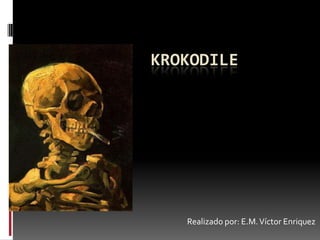Krokodile (2)
- 1. KROKODILE Realizado por: E.M. Víctor Enriquez
- 2.  'Krokodile' apareció en Rusia en 2002 y se fue instalando entre los consumidores de drogas de menos poder adquisitivo.  Era barata y parecía heroína, aunque sus efectos psicotrópicos duran apenas dos horas.
- 4.  La esperanza de vida es menos de tres años.  Muerte por envenenamiento de la sangre, meningitis, neumonía o, literalmente, podridos.  Las autoridades alemanas, después de descubrir los primeros casos, advirtieron que una simple dosis es suficiente para matar.
- 5. Alemania  Según los datos del Observatorio Europeo de Drogas y Toxicomanías, los casos descubiertos en Europa occidental, por su escaso número, son anecdóticos, pero las autoridades de la ciudad alemana de Bochum tienen censados al menos a cuatro personas afectadas. Y Axel Pütter, portavoz de la policía de Bochum, dijo a la agencia AFP que tienen conocimiento de casos "por toda Alemania".
- 7. Rusia  Según estimaciones de la prensa rusa, habría más de un millón de adictos -entre ellos más de 100.000 menores de 18 años, todos con una tasa de mortalidad mucho mayor que otros consumidores de drogas.  Adicción a heroina mata 30, 000 personas al año.
- 8. krokodile  En Rusia su expansión parece incontenible.  People literally rot to death.  Mr Ivanov recalled a recent visit to a drug- treatment centre in Western Siberia. "They told me that two years ago almost all their drug users used heroin," said the drugs tsar. "Now, more than half of them are on desomorphine."
- 9.  Mezcla de heroína, gasolina, codeína, disolvente para pintura, yodo y fósforo rojo. Según los países, cuesta de tres a diez veces menos que la heroína y todos sus componentes son fáciles de comprar en el mercado legal.
- 10. ÔÇß "Over the past five years, sales of codeine-based tablets have grown by dozens of times," says Viktor Ivanov, the head of Russia's Drug Control Agency. "It's pretty obvious that it's not because everyone has suddenly developed headaches."
- 11. ÔÇß La Heroina cuesta 20-50 euros por dosis, al sintetizarla se puede obtener por 2 euros. ÔÇß "If you miss the vein, that's an abscess straight away," says Sasha. ÔÇß "She won't go to hospital, she just keeps injecting. Her flesh is falling off and she can hardly move anymore," says Sasha.
- 12. ÔÇß Russia tiene dos millones de usuarios de heroina, el mayor n√∫mero en el mundo. ÔÇß "With heroin withdrawal, the main symptoms last for five to 10 days. After that there is still a big danger of relapse but the physical pain will be gone. With krokodil, the pain can last up to a month, and it's unbearable. They have to be injected with extremely strong tranquilisers just to keep them from passing out from the pain."
- 13. ÔÇß 5% de consumidores de droga rusos aprox. 10 000 adictos consumen krokodile. ÔÇß No se necesita receta para comprar codeina.
- 14.  Dr Yegorov says krokodil users are instantly identifiable because of their smell. "It's that smell of iodine that infuses all their clothes," he says. "There's no way to wash it out, all you can do is burn the clothes. Any flat that has been used as a krokodil cooking house is best forgotten about as a place to live. You'll never get that smell out of the flat.”
- 15. ÔÇß Most krokodil users inject the drug only when they run out of money for heroin. As soon as they earn or steal enough, they go back to heroin. In other more isolated regions of Russia, where heroin is more expensive and people are poorer, the problem is worse. People become full-time krokodil addicts, giving them a life expectancy of less than a year.
- 16. "You can feel how disgusting it is when you're doing it," he recalls. "You're dreaming of heroin, of something that feels clean and not like poison. But you can't afford it, so you keep doing the krokodil. Until you die."
- 18. Krokodil":revival of an old drug with new problems. Autor: Gahr, Maximilian; Freudenmann, Roland W; Hiemke, Christoph; Gunst, Ingo M; Connemann, Bernhard J;  Información de publicación: Substance use & misuse 47. 7 (June 2012): 861-863.  Resumen: In order to summarize current knowledge about the drug "Krokodil" a systematic review including a iterature search of the databases PubMed, Embase, Scopus, and Google was conducted in December 2011.  According to information acquired, "Krokodil" is a mixture of several substances and was first reported to have been used in Russia in 2003.  The core agent of "Krokodil" is desomorphine, an opioid-analogue that can be easily and cheaply manufactured by oneself. Self- production results in a contaminated suspension that is injected intravenously. Due to its pharmacologic features, desomorphine shows a high potential to cause dependence.
- 19. Emerging drug in Ukraine: “Crocodile” desomorphine  Category: Epidemiology Year: 2012  P. Smyrnov, S. Tatyana. International HIV/AIDS Alliance, Ukraine  Background: During a series of interviews with drug users conducted in July 2011 in Kyiv, Ukraine, many respondents mentioned desomorphine as a new popular street drug.  Street desomorphine (named “crocodile”) is prepared by users from codeine-containing pills, red phosphorus, and iodine. This drug is very popular in neighboring Russia, but fewer reports on its use were received from Ukraine.  Conclusion: Analysis of data from the BSS conducted in Ukraine in 2011 suggests that in the drug scene in Ukraine, crocodile has become a popular drug of choice; especially in some cities, it is important to monitor its use and adjust harm reduction interventions accordingly.
- 20. Desomorfina






















